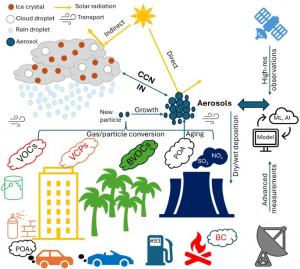From dust to storms: unraveling the mystery of atmospheric aerosols
GA, UNITED STATES, September 17, 2025 /EINPresswire.com/ -- Aerosols—microscopic particles adrift in the atmosphere—hold the power to influence storms, cloud formation, and even the trajectory of climate change. Recent research is uncovering how these particles form, grow, and interact with weather systems, reshaping our ability to predict both local air quality and long-term climate trends. By combining satellite observations, ground-based monitoring, and machine learning, scientists are constructing more accurate models of aerosol behavior. Yet uncertainties remain, particularly in how natural emissions blend with human-made pollution. This review highlights a path forward: integrating advanced data and computational tools to close knowledge gaps and deliver more reliable climate forecasts.
From sea spray and volcanic eruptions to factory smokestacks and traffic exhaust, aerosols emerge from countless sources. Their impacts reach far beyond hazy skies. Fine particulate matter (PM2.5), for instance, is linked to millions of premature deaths worldwide, while certain aerosols can seed clouds, intensify cyclones, or shift rainfall patterns. Some reflect sunlight, cooling the Earth, while others trap heat, fueling warming. The delicate balance between these opposing effects makes aerosols one of the greatest uncertainties in climate science. Because of these challenges, researchers need to deepen their understanding of how aerosols are formed and how they influence both weather and climate.
A team of atmospheric scientists has released a sweeping review n Frontiers of Environmental Science & Engineering (online July 30, 2025), offering fresh insights into the role of aerosols in shaping climate and weather. The article, pulls together the latest discoveries in nucleation chemistry, aerosol-cloud dynamics, and machine learning applications. Their conclusion is clear: unlocking the secrets of aerosols is essential for more accurate predictions of our planet's future.
The review paints a vivid picture of aerosols as both products of natural cycles and byproducts of human activity. Primary aerosols—from sea spray or industrial smoke—enter the air directly, while secondary aerosols emerge through intricate chemical reactions, turning invisible gases into particles that can alter skies and storm systems.
Recent breakthroughs reveal surprising actors in this drama. Sulfuric acid, highly oxygenated organic molecules, and even trace amounts of iodic acid can trigger particle formation. Biogenic compounds like sesquiterpenes, emitted by plants, were shown to double new particle growth in controlled studies—an overlooked factor now recognized as central to global climate modeling.
The review also tracks progress in computational tools. High-resolution emission inventories, bolstered by satellites and refined with machine learning, are producing sharper maps of pollution sources and their impacts. Models that once struggled with uncertainty are now capturing how volatile compounds evolve, how particles age, and how aerosols act as cloud seeds.
Still, challenges loom. Simulating the delicate dance between natural and human-driven emissions, or decoding how aerosols reshape rainfall and storm intensity, remains daunting. To address this, the authors propose a "process-to-climate" framework that harnesses supercomputing and machine learning to link microscopic reactions with global-scale outcomes.
"The story of aerosols is a story of complexity and consequence," the authors emphasized. "These particles can cool or warm the Earth, clear the air or choke it, depending on their chemistry and context. Our review shows encouraging progress—new instruments, new data streams, and new algorithms are rewriting what we know. But we are still grappling with large uncertainties, especially in cloud interactions. Closing these gaps will demand cross-disciplinary collaboration, so that policymakers and communities can rely on models that better reflect reality".
Sharper aerosol models promise wide-reaching benefits. In public health, tracing PM2.5 to its sources can inform targeted regulations and save lives. In meteorology, better representations of aerosol-cloud interactions could improve rainfall forecasts, critical for agriculture and disaster preparedness. On the climate stage, reducing uncertainties about aerosol effects will strengthen predictions of global warming and help refine international climate goals. The fusion of satellite monitoring, on-the-ground observations, and artificial intelligence is not just advancing science—it is building the foundation for policies and strategies that could shape the world’s environmental future.
References
DOI
10.1007/s11783-025-2063-y
Original Source URL
https://doi.org/10.1007/s11783-025-2063-y
Funding information
This study was supported by the National Natural Science Foundation of China (No. 42322902), and the Research Grants Council of the Hong Kong Special Administrative Region, China (Project Nos. C2002-22Y, HKBU12201023, and HKBU12202021).
Lucy Wang
BioDesign Research
email us here
Legal Disclaimer:
EIN Presswire provides this news content "as is" without warranty of any kind. We do not accept any responsibility or liability for the accuracy, content, images, videos, licenses, completeness, legality, or reliability of the information contained in this article. If you have any complaints or copyright issues related to this article, kindly contact the author above.

